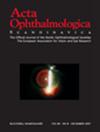Isolated corneal intraepithelial neoplasia: An unheard variety
Abstract
Aims/Purpose: The purpose of this clinical case is to present the symptoms, as well as biomicroscopical, tomographical and histological findings of the isolated corneal intraepithelial neoplasia, a very rare variety of ocular surface squamous neoplasia.
Methods: We present the case of a 78-year-old woman with foreign body sensation in her right eye for four months. The cornea presented, apart from crocodile shagreen, a white patch in the temporal-inferior quadrant, separate from the limbus. This lesion showed punctate staining and contained a thin line of normal aspect. The optical coherence tomography (OCT) showed hyperreflective and thickened epithelium with sudden transition to normal cornea.
On suspicion of corneal intraepithelial neoplasia, excisional biopsy was indicated, with Shields's non-touch technique, 2 mm surgical margins and absolute-alcohol application on the limbus.
Furthermore, a review of the past 25 years literature has been performed, using the following key words: corneal intraepithelial neoplasia; ocular surface squamous neoplasia.
Results: The histological result showed a corneal intraepithelial neoplasia with non-assessable margins. One week after surgery, the defect had already been replaced by normal epithelium, and we added two cycles of co-adjuvant topical mitomycin C (0.04%). Two years after surgery, the patient is asymptomatic and with no signs of recurrence.
Regarding the review, only 10 cases of isolated corneal intraepithelial neoplasia have been described in the past 25 years. No references of crocodile shagreen concurrence have been found, whereas there is some consensus of surgery as main treatment and OCT as useful diagnostic tool.
Conclusions: Isolated corneal intraepithelial neoplasia should always be included in differential diagnosis when it comes to a thickened and atypical lesion in the cornea. In this context, OCT can be useful, whereas final diagnosis and treatment should include excisional biopsy.

 求助内容:
求助内容: 应助结果提醒方式:
应助结果提醒方式:


